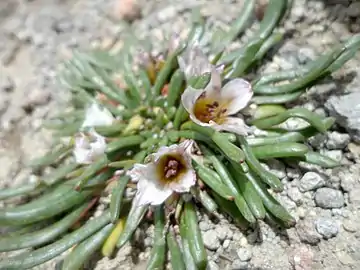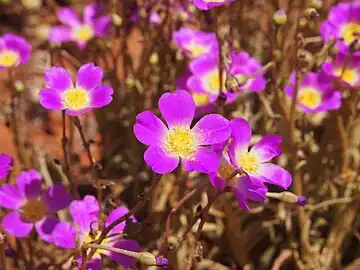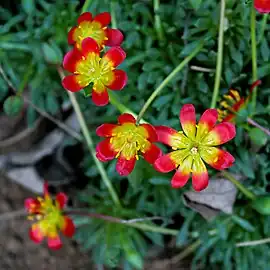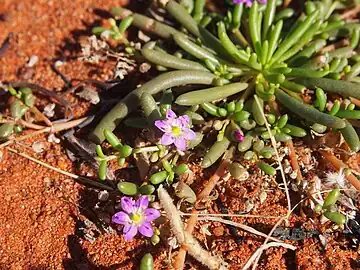Calandrinia
Calandrinia is a large genus of flowering plants known as purslanes and redmaids. It includes over 100 species of annual and perennial herbs which bear colorful flowers in shades of red to purple and white. Plants of this genus are native to Australia, western South America, Central America, and western North America. Some species have been introduced to parts of New Zealand, southern Africa, Asia, and Europe.[1]
| Calandrinia | |
|---|---|
.jpg.webp) | |
| Calandrinia colchaguensis | |
| Scientific classification | |
| Kingdom: | Plantae |
| Clade: | Tracheophytes |
| Clade: | Angiosperms |
| Clade: | Eudicots |
| Order: | Caryophyllales |
| Family: | Montiaceae |
| Genus: | Calandrinia Kunth |
| Synonyms[1] | |
| |
Description
Species in the genus Calandrinia are annual or perennial herbaceous plants with a sprawling or erect habit. The leaves are mostly basal and may be either alternate or opposite in arrangement. Flowers are produced in cymes. Each flower produces between four and eleven petals, though often five. Flowers may be white, purple, pink, red, or yellow.[2][3][4]
 Calandrinia acaulis
Calandrinia acaulis.jpg.webp) Calandrinia affinis
Calandrinia affinis
 Calandrinia caespitosa
Calandrinia caespitosa Calandrinia stagnensis
Calandrinia stagnensis
Taxonomy
The genus Calandrinia was erected in 1823 by German botanist Carl Sigismund Kunth.[5][6] It was named for Jean Louis Calandrini (1703–1758), a Genevan botanist.[3]
Approximately 74 Calandrinia species are native to Australia.[7] Along with the pigweeds (Portulaca species), Calandrinia are the most prominent succulent species in Australia.[8] The Australian Calandrinia were traditionally considered to be monophyletic (share the same ancestry) with 14 Calandrinia species from the Americas, and are still classified as belonging to the same genus.[9] However, in 1987 Australian taxonomist Roger Carolin proposed that the American and Australian Calandrinia are not closely related to each other based on morphological analyses. Follow-up studies also supported two different lineages, based in part on the absence of Calandrinia on islands along possible dispersal pathways between South America and Australia and in part on genomic data.[10][7]
Despite this, the nomenclature has not been officially changed for all Australian Calandrinia, including C. balonensis. Although the need for a nomenclature change is widely agreed, a debate has arisen over the appropriate naming of the Australian Calandrinia.[11] A proposal has been made to rename the genus as Parakeelya on the grounds that it is used as a common name for the whole genus, derives from South Australian and Central Desert Indigenous names, and is already accepted as a synonym for some Australian species.[12] The competing view holds that the Australian genus should be named Rumicastrum according to established nomenclatural rules.[11] The proposal to rename Calandrinia as Parakeelya has not yet been decided.[9]
The genus is classified in the family Montiaceae.[1] It was previously placed in the purslane family, Portulacaceae.[3]
Species
As of 2019, accepted species in Kew's Plants of the World Online include:[1]
- Calandrinia acaulis Kunth
- Calandrinia affinis Gillies ex Arn.
- Calandrinia alba (Ruiz & Pav.) DC.
- Calandrinia arenicola Syeda
- Calandrinia baccata Obbens
- Calandrinia balonensis Lindl. – broadleaf parakeelya
- Calandrinia bracteosa Phil.
- Calandrinia brevipedata F.Muell.
- Calandrinia breweri S.Watson – Brewer's redmaid
- Calandrinia caesia F.Phil. ex Phil.
- Calandrinia caespitosa Gillies ex Arn.
- Calandrinia calycotricha Phil.
- Calandrinia calyptrata Hook.f. – pink purslane
- Calandrinia carolinii Hershk. & D.I.Ford
- Calandrinia ciliata (Ruiz & Pav.) DC. – fringed redmaid
- Calandrinia colchaguensis Barnéoud
- Calandrinia compacta Barnéoud
- Calandrinia composita (Nees) Benth.
- Calandrinia compressa Schrad. ex DC.
- Calandrinia conferta Gillies ex Arn.
- Calandrinia corrigioloides F.Muell. ex Benth. – strap purslane
- Calandrinia corymbosa Walp.
- Calandrinia crassifolia Phil.
- Calandrinia creethae Tratman ex Morrison
- Calandrinia crispisepala Obbens
- Calandrinia cygnorum Diels
- Calandrinia cylindrica Poelln.
- Calandrinia depressa Phil.
- Calandrinia dielsii Poelln.
- Calandrinia dipetala J.M.Black
- Calandrinia disperma J.M.Black
- Calandrinia eremaea Ewart – twining purslane
- Calandrinia filifolia Rydb.
- Calandrinia flava Obbens
- Calandrinia fuegiana Gand.
- Calandrinia galapagosa H.St.John
- Calandrinia glaucopurpurea Reiche
- Calandrinia gracilis Benth.
- Calandrinia graminifolia Phil.
- Calandrinia granulifera Benth. – pygmy purslane
- Calandrinia heterophylla Rydb.
- Calandrinia hirtella Phil.
- Calandrinia hortiorum Obbens
- Calandrinia involucrata Phil.
- Calandrinia kalanniensis Obbens
- Calandrinia lancifolia Phil.
- Calandrinia leucopogon Phil.
- Calandrinia leucotricha Phil.
- Calandrinia liniflora Fenzl
- Calandrinia litoralis Phil.
- Calandrinia maryonii S.Moore
- Calandrinia meyeniana Walp.
- Calandrinia minutissima Barnéoud
- Calandrinia mirabilis Chinnock & J.G.West
- Calandrinia monandra (Ruiz & Pav.) DC.
- Calandrinia monogyna Poelln.
- Calandrinia morrisae Goy
- Calandrinia mucronulata Meyen
- Calandrinia nana Phil.
- Calandrinia nitida (Ruiz & Pav.) DC.
- Calandrinia oblonga Syeda & Carolin
- Calandrinia operta Obbens
- Calandrinia oraria Obbens
- Calandrinia papillata Syeda
- Calandrinia pauciflora Phil.
- Calandrinia pentavalvis Obbens
- Calandrinia pilosiuscula DC.
- Calandrinia pleiopetala F.Muell.
- Calandrinia poeppigiana Walp.
- Calandrinia pogonophora F.Muell.
- Calandrinia polyandra Benth.
- Calandrinia polyclados Phil.
- Calandrinia polypetala Fenzl
- Calandrinia porifera Syeda
- Calandrinia primuliflora Diels
- Calandrinia procumbens Moris
- Calandrinia ptychosperma F.Muell.
- Calandrinia pumila (Benth.) F.Muell.
- Calandrinia quadrivalvis F.Muell.
- Calandrinia ranunculina J.M.Watson, A.R.Flores & Elvebakk
- Calandrinia remota J.M.Black
- Calandrinia reticulata Syeda
- Calandrinia rubrisabulosa Obbens
- Calandrinia sanguinea Phil.
- Calandrinia schistorhiza Morrison
- Calandrinia setosa Phil.
- Calandrinia sitiens I.M.Johnst.
- Calandrinia skottsbergii Gand.
- Calandrinia solisi Phil.
- Calandrinia spectabilis Otto & A.Dietr.
- Calandrinia spergularina F.Muell.
- Calandrinia sphaerophylla J.M.Black
- Calandrinia spicata Phil.
- Calandrinia spicigera Phil.
- Calandrinia stagnensis J.M.Black
- Calandrinia stenogyna Domin
- Calandrinia strophiolata (F.Muell.) F.Muell.
- Calandrinia taltalensis I.M.Johnst.
- Calandrinia tepperiana W.Fitzg.
- Calandrinia tholiformis Obbens
- Calandrinia translucens Obbens
- Calandrinia tricolor Phil.
- Calandrinia tumida Syeda
- Calandrinia umbelliformis Obbens
- Calandrinia uniflora F.Muell.
- Calandrinia villanuevae Phil.
- Calandrinia villaroelii Phil.
- Calandrinia virgata Phil.
- Calandrinia volubilis Benth.
Uses
Calandrinia balonensis is recorded in the 1889 book The Useful Native Plants of Australia as being called "periculia" by Indigenous Australians and that the plant was eaten by Europeans with bread while Indigenous Australians used it as a food when mixed with baked bark. "The seed is used for making a kind of bread, after the manner of that of Portulaca oleracea. (Mueller, Fragm., x., 71.)."[13]
References
- "Calandrinia Kunth". Plants of the World Online. Royal Botanical Gardens Kew. Retrieved 8 January 2019.
- "Calandrinia". vicflora.rbg.vic.gov.au. VicFlora, Royal Botanic Gardens Victoria. Retrieved 11 January 2019.
- Kelley, Walter A. (2003). "Calandrinia". In Flora of North America Editorial Committee (ed.). Flora of North America North of Mexico (FNA). Vol. 4. New York and Oxford: Oxford University Press. Retrieved 11 January 2019 – via eFloras.org, Missouri Botanical Garden, St. Louis, MO & Harvard University Herbaria, Cambridge, MA.
- Elvebakk, Arve; Flores, Ana Rosa; Watson, John Michael (19 March 2015). "Revisions in the South American Calandrinia caespitosa complex (Montiaceae)". Phytotaxa. 203 (1): 1. doi:10.11646/phytotaxa.203.1.1.
- Kunth in Humb., Bonpl. & Kunth, Nov. Gen. et Sp. vi. 1823. Page 77. Illustration.
- "Calandrinia Kunth". ipni.org. International Plant Names Index. Retrieved 8 January 2019.
- Hancock, L.P, Obbens, F., Moore, A.J., Thiele, K., de Vos, J.M, West, J., and Edwards, E.J. (2018). "Phylogeny, evolution, and biogeographic history of Calandrinia (Montiaceae)". American Journal of Botany. 105 (6): 1021–1034. doi:10.1002/ajb2.1110. PMID 29995314. S2CID 51612043.
{{cite journal}}: CS1 maint: multiple names: authors list (link) - Low, T. (2016). "Where are all the succulents?". Wildlife Australia. 53: 12–14.
- Thiele, Kevin (2018-12-29). "On the Horizon: Calandrinia changing to Parakeelya". Taxonomy Australia. Retrieved 2020-10-18.
- Tahir, S.S. and Carolin, R.C. (1990). "Phylogeny and origin of Australian Calandrinia (Portulacaceae)". Pakistan Journal of Botany. 22: 1–4.
{{cite journal}}: CS1 maint: multiple names: authors list (link) - Hershkovitz, M.A. (2020). "Rumicastrum Ulbrich (Montiaceae): a beautiful name for the Australian calandrinias". Phytologia. 102: 116–123.
- Thiele, K.R., Obbens, L., Hancock, E., Edwards, E. and West, J.G. (2018). "Proposal to conserve the name Parakeelya against Rumicastrum". Taxon. 67: 214–215. doi:10.12705/671.25.
{{cite journal}}: CS1 maint: multiple names: authors list (link) - J. H. Maiden (1889). The useful native plants of Australia : Including Tasmania. Turner and Henderson, Sydney.